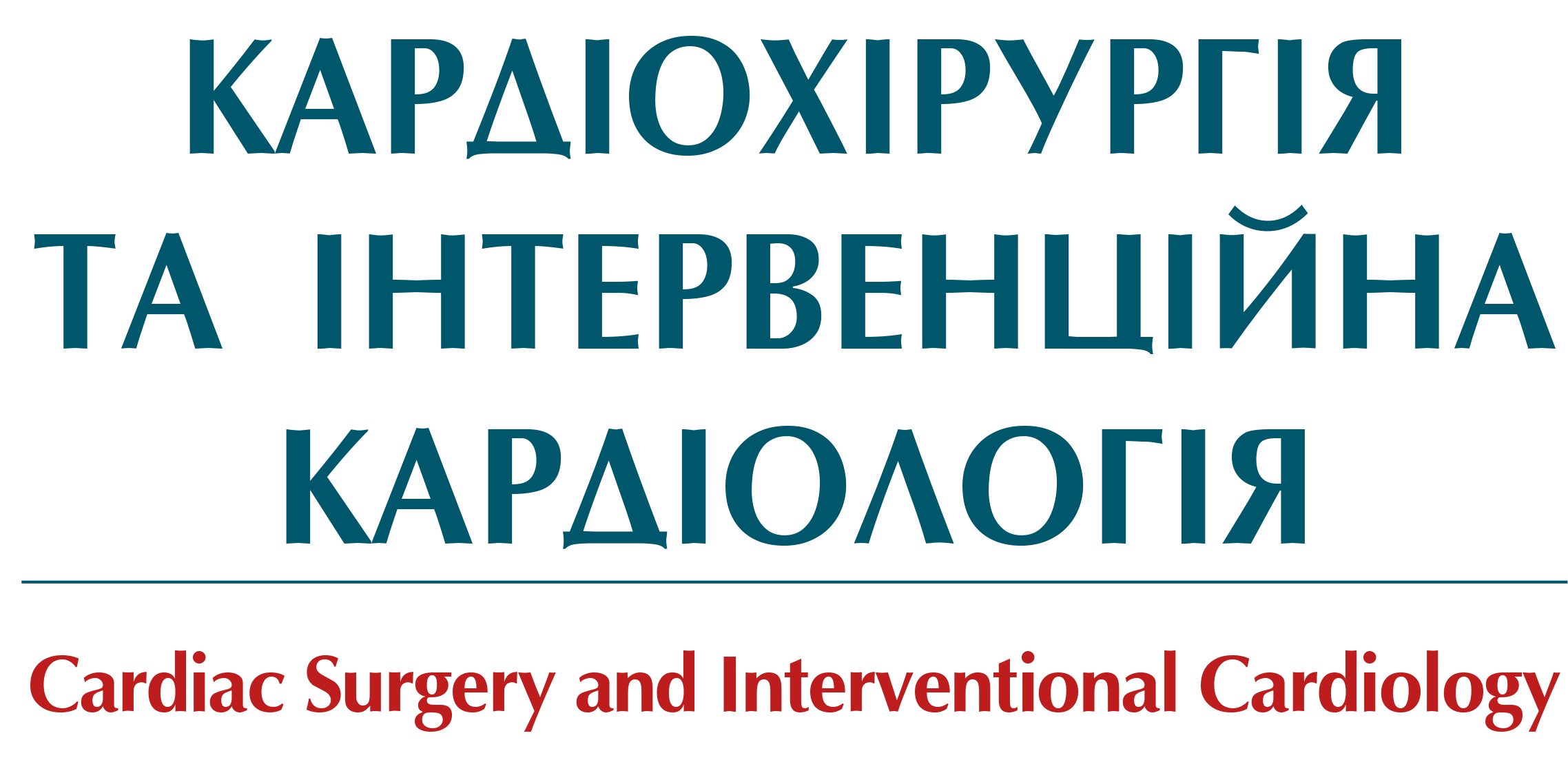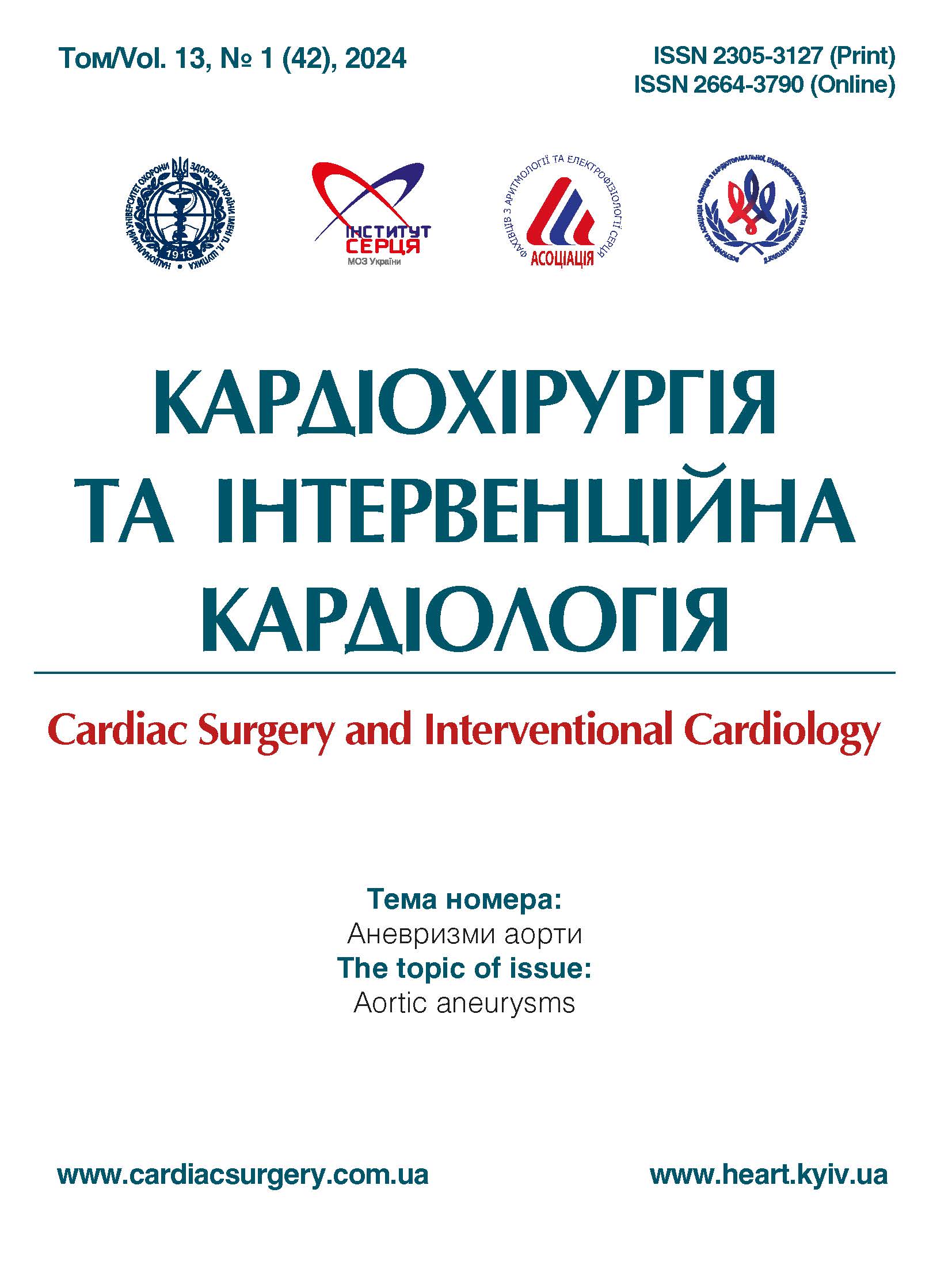Особливості гемодинаміки в пацієнтів старшої вікової групи з ішемічною хворобою серця при застосуванні комбінації препаратів пропофолу, кетаміну та фентанілу для індукції в анестезію
##plugins.themes.bootstrap3.article.main##
Анотація
Мета роботи – проаналізувати зміни гемодинаміки в пацієнтів старшого віку з ішемічною хворобою серця (ІХС) під час операції аортокоронарного шунтування на етапі індукції в анестезію із застосуванням пропофолу, кетаміну та фентанілу.
Матеріали і методи. Представлено результати обстеження 20 пацієнтів віком понад 60 років з ІХС, котрим було проведено операцію аортокоронарного шунтування без застосування штучного кровообігу. Параметри гемодинаміки реєстрували на етапах: 1) на момент прибуття пацієнта в операційну; 2) після введення препаратів для індукції в анестезію; 3) після інтубації; 4) через 25 хвилин після інтубації трахеї.
Результати та обговорення. На момент прибуття до операційної гемодинамічні параметри свідчили про стабільний загальний стан пацієнтів. Після введення комбінації препаратів для індукції пропофол + фентаніл + кетамін у дозуванні згідно з дизайном дослідження виявлено, що зменшилися такі показники: середній артеріальний тиск (АТср) – на 18,71 %, частота скорочень серця (ЧСС) – на 4,72 %, серцевий індекс (СІ) – на 14,37 %, індекс загального периферійного судинного опору (ІЗПСО) – на 3,93 %. Після встановлення інтубаційної трубки АТср становив (92,34±7,26) %, ЧСС – (100,81 ± 9,77) %, СІ – (110,38 ± 12,37) %, ІЗПСО – (83,57 ± 10,70) % вихідного рівня. Через 25 хвилин після успішної інтубації трахеї було повторно зареєстровано параметри, що становили у відсоткових значеннях вихідних показників: АТср – (86,47 ± 6,07) %; ЧСС – (100,08 ± 5,03) %; СІ – (108,29 ± 9,95) %; ІЗПСО – (77,86 ± 9,83) %.
Висновки. Оскільки гіпотензія є частим побічним ефектом дії традиційних препаратів для індукції в анестезію, таких як пропофол та фентаніл, додавання кетаміну до цієї комбінації сприяє стабілізації показників гемодинаміки і запобігає небажаним гемодинамічним коливанням.
##plugins.themes.bootstrap3.article.details##
Ключові слова:
Посилання
American Heart Association (AHA) - 2021 Heart Disease & Stroke Statistical Update Fact Sheet Older Americans & Cardiovascular Diseases.
Коshelya ІІ, Skryp VV. [Epidemiology of ischaemic heart diseaseand myocardial infarction in Transcarpathian region]. Ukraine. Nation’s Health. 2019;3(56):51-4. https://doi.org/10.24144/2077-6594.3.2019.191633. Ukrainian.
Jaber S, Amraoui J, Lefrant JY, Arich C, Cohendy R, Landreau L, Calvet Y, Capdevila X, Mahamat A, Eledjam JJ. Clinical practice and risk factors for immediate complications of endotracheal intubation in the intensive care unit: a prospective, multi- ple-center study. Crit Care Med. 2006;34:2355-61. https://doi.org/10.1097/01.CCM.0000233879.58720.87.
Mort TC, Waberski BH, Clive J Extending the preoxygenation period from 4 to 8 mins in critically ill patients undergoing emergency intubation. Crit Care Med. 2009;37:68-71. https://doi.org/10.1097/CCM.0b013e318192845e
Südfeld S, Brechnitz S, Wagner JY, Reese PC, Pinnschmidt HO, Reuter DA, Saugel B. Post-induction hypotension and early intraoperative hypotension associated with general anaesthesia. Br J Anaesth. 2017;119:57-64. https://doi.org/10.1093/bja/aex127.
Jor O, Maca J, Koutna J, Gemrotova M, Vymazal T, Litschmannova M, Sevcik P, Reimer P, Mikulova V, Trlicova M, Cerny V. Hypotension after induction of general anesthesia: occurrence, risk factors, and therapy. A prospective multicentre observational study. J Anesth. 2018;32:673-80. https://doi.org/10.1007/s00540-018-2532-6.
Reich DL, Hossain S, Krol M, Baez B, Patel P, Bernstein A, Bodian CA. Predictors of hypotension after induction of general anesthesia. Anesth Analg. 2005;101:622-8. https://doi.org/10.1213/01.ANE.0000175214.38450.91.
Indolfi C, Ross J Jr. The role of heart rate in myocardial ischemia and infarction: Implications of myocardial perfusion-contraction matching. Prog Cardiovasc Dis. 1993 Jul-Aug;36(1):61-74. https://doi.org/10.1016/0033-0620(93)90022-6.
Presta P, Lucisano G, Fuiano L, Fuiano G.The kidney and the elderly: why does the risk increase? Int Urol Nephrol. 2012 Apr;44(2):625-32. https://doi.org/10.1007/s11255-011-0063-2.
Martin JE, Sheaff MT.. Renal ageing. J Pathol. 2007 Jan;211(2):198-205. https://doi.org/1 10.1002/path.2111.
Russotto V, Myatra SN, Laffey JG, Tassistro E, Antolini L, Bauer P, Lascarrou JB, Szuldrzynski K, Camporota L, Pelosi P, Sorbello M, Higgs A, Greif R, Putensen C, Agvald-Öhman C, Chalkias A, Bokums K, Brewster D, Rossi E, Fumagalli R, Pesenti A, Foti G, Bellani G; INTUBE Study Investigators. Intubation practices and adverse peri-intubation events in critically ill patients from 29 countries. JAMA. 2021;325(12):1164-72. https://doi.org/10.1001/jama.2021.1727.
Smischney NJ, Demirci O, Ricter BD, Hoeft CC, Johnson LM, Ansar S, Kashyap R. Vasopressor use as a surrogate for post-intubation hemodynamic instability is associated with in-hospital and 90-day mortality: a retrospective cohort study. BMC Res Notes. 2015;8:445. https://doi.org/10.1186/s13104-015-1410-7.
Janz DR, Casey JD, Semler MW, Russell DW, Dargin J, Vonderhaar DJ, Dischert KM, West JR, Stempek S, Wozniak J, Caputo N, Heideman BE, Zouk AN, Gulati S, Stigler WS, Bentov I, Joffe AM, Rice TW; PrePARE. Effect of a fluid bolus on cardiovascular collapse among critically ill adults undergoing tracheal intubation (PrePARE): a randomised controlled trial. Lancet Respir Med. 2019;7(12):1039-47. https://doi.org/10.1016/S2213-2600(19)30246-2.
Smischney NJ, Demirci O, Diedrich DA, Barbara DW, Sandefur BJ, Trivedi S, McGarry S, Kashyap R. Incidence of and risk factors for post-intubation hypotension in the critically ill. Med Sci Monit. 2016;22:346-55. https://doi.org/10.12659/MSM.895919
Griffiths R, Beech F, Brown A, Dhesi J, Foo I, Goodall J, Harrop-Griffiths W, Jameson J, Love N, Pappenheim K, White S; Association of Anesthetists of Great Britain and Ireland. Peri-operative care of the elderly 2014: association of anesthetists of Great Britain and Ireland. Anaesthesia. 2014 Jan;69 Suppl 1:81-98. https://doi.org/10.1111/anae.12524.
Stern, Y. Cognitive reserve. Neuropsychologia. 2009 Aug;47(10):2015-28. https://doi.org/10.1016/j.neuropsychologia.2009.03.004.
Tu W, Yuan H, Zhang S, Lu F, Yin L, Chen C, Li J. Influence of anesthetic induction of propofol combined with esketamine on perioperative stress and inflammatory responses and postoperative cognition of elderly surgical patients, Am J Transl Res. 2021 Mar 15;13(3):1701-9. eCollection 2021.
Zhou N, Liang X, Gong J, Li H, Liu W, Zhou S, Xiang W, Li Z, Huang Y, Mo X, Li W. S-ketamine used during anesthesia induction increases the perfusion index and mean arterial pressure after induction: A randomized, double-blind, placebo-controlled trial. Eur J Pharm Sci. 2022 Dec 1;179:106312. https://doi.org/10.1016/j.ejps.2022.106312.
Trimmel H, Helbok R, Staudinger T, Jaksch W, Messerer B, Schöchl H, Likar R. S(+)-ketamine: Current trends in emergency and intensive care medicine. Wien Klin Wochenschr. 2018 May;130(9-10):356-66. https://doi.org/10.1007/s00508-017-1299-3.
Loomba RS, Gray SB, Flores S. Hemodynamic effects of ketamine in children with congenital heart disease and/or pulmonary hypertension. Congenit Heart Dis. 2018 Sep;13(5):646-54. https://doi.org/10.1111/chd.12662.


 https://orcid.org/0000-0003-3282-6539
https://orcid.org/0000-0003-3282-6539